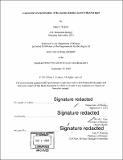| dc.contributor.advisor | David C. Page. | en_US |
| dc.contributor.author | Kojima, Mina L | en_US |
| dc.contributor.other | Massachusetts Institute of Technology. Department of Biology. | en_US |
| dc.date.accessioned | 2019-01-11T16:07:17Z | |
| dc.date.available | 2019-01-11T16:07:17Z | |
| dc.date.copyright | 2018 | en_US |
| dc.date.issued | 2018 | en_US |
| dc.identifier.uri | http://hdl.handle.net/1721.1/119982 | |
| dc.description | Thesis: Ph. D., Massachusetts Institute of Technology, Department of Biology, 2018. | en_US |
| dc.description | Cataloged from PDF version of thesis. | en_US |
| dc.description | Includes bibliographical references. | en_US |
| dc.description.abstract | Sexual reproduction requires meiosis, a cellular division program in which one round of DNA replication precedes two rounds of chromosome segregation to produce haploid gametes. In most organisms, accurate meiotic chromosome segregation depends on the pairing and synapsis of homologous chromosomes and crossing over during prophase of meiosis I. These chromosomal events are generally conserved across eukaryotes and have been extensively studied. In contrast, the regulation of meiotic initiation is less understood. In this thesis, we aim to fill this knowledge gap by providing a molecular framework for understanding how germ cells in mice undergo meiotic initiation. In mice, previous genetic studies have shown that the germ cell-specific gene Stimulated by retinoic acid 8 (Stra8) is required to initiate all events of meiotic prophase I. The STRA8 protein has long been assumed to be a transcription factor, but in vivo biochemical evidence of its function has been lacking. I present evidence demonstrating that STRA8 indeed functions at meiotic initiation as a transcriptional activator, and that it primarily binds gene promoters. We find that STRA8 directly upregulates many meiotic prophase genes. However, such genes represent a small fraction of the unexpectedly broad ensemble of genes that STRA8 upregulates: at least a thousand genes. Many of these genes have been extensively studied in the context of the mitotic cell cycle and are known targets of cell cycle-driving transcription factors. Specifically, many STRA8-activated genes are key proteins at the Gl -S transition and for DNA replication. We thus provide evidence that a single factor - STRA8 - directly coordinates the expression of meiotic prophase genes with that of other genes that mark the start of a new cell cycle. In no other organism has the binding of a meiosis-initiating factor been probed on a genome-wide scale. Thus, our findings about STRA8 lay the foundation for future work towards a better understanding of how eukaryotes regulate transcriptional programs for meiotic initiation. | en_US |
| dc.description.statementofresponsibility | by Mina L. Kojima. | en_US |
| dc.format.extent | 174, 33 pages | en_US |
| dc.language.iso | eng | en_US |
| dc.publisher | Massachusetts Institute of Technology | en_US |
| dc.rights | MIT theses are protected by copyright. They may be viewed, downloaded, or printed from this source but further reproduction or distribution in any format is prohibited without written permission. | en_US |
| dc.rights.uri | http://dspace.mit.edu/handle/1721.1/7582 | en_US |
| dc.subject | Biology. | en_US |
| dc.title | A molecular characterization of the meiotic initiation factor STRA8 in mice | en_US |
| dc.type | Thesis | en_US |
| dc.description.degree | Ph. D. | en_US |
| dc.contributor.department | Massachusetts Institute of Technology. Department of Biology | |
| dc.identifier.oclc | 1080642823 | en_US |
